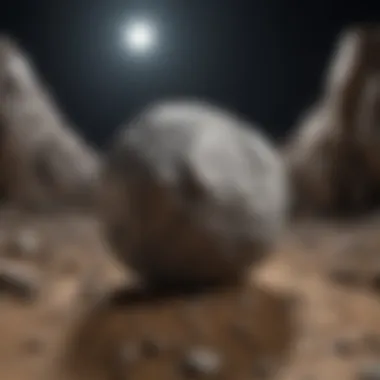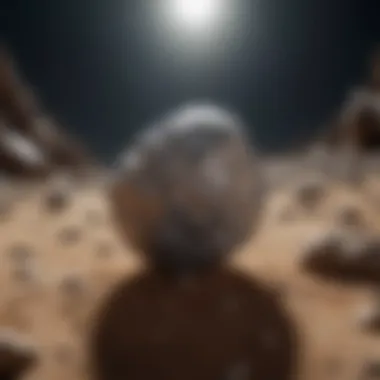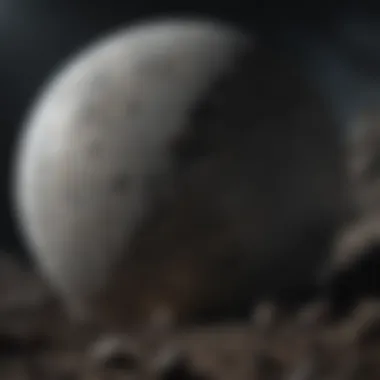Unveiling the Enigmatic World of Purchasing Lunar Meteorites and Moon Rocks


Rock and Fossil Identification
In the realm of lunar meteorites and moon rocks, identification stands as a crucial step in determining the authenticity and value of these extraterrestrial specimens. Various types of rocks and fossils exist, each with distinct characteristics that aid in their classification. The geological landscape of the moon presents a diverse array of materials, ranging from basaltic lunar mare to anorthositic highlands.
Understanding the characteristics to look for is paramount for collectors venturing into the world of lunar acquisitions. Features such as crystallization patterns, mineral composition, and fusion crusts play pivotal roles in differentiating between genuine moon rocks and terrestrial counterparts. Additionally, anomalies like regmaglypts and vesicles can offer essential clues about the moon rock's origin and journey through space.
While traditional tools for rock and fossil identification are valuable, such as hand lenses and UV lights, specialized equipment geared towards extraterrestrial analysis, like electron microscopes and mass spectrometers, are indispensable for discerning the unique properties of lunar meteorites.
Preservation and Display
Preserving the integrity of acquired lunar materials involves employing meticulous techniques to safeguard their scientific and aesthetic value. Specialized methods such as vacuum sealing and desiccation help prevent deterioration caused by exposure to terrestrial elements. Storing moon rocks in controlled environments, free from moisture and contaminants, ensures their longevity and protects their pristine nature.
When it comes to displaying these celestial treasures, creativity knows no bounds. From elegant glass cases with built-in LED lighting to minimalist floating shelves that highlight the natural beauty of moon rocks, collectors have a plethora of options to showcase their prized acquisitions. Innovative approaches like incorporating moon rock fragments into custom jewelry or integrating them into art installations elevate the allure of owning a piece of the moon.
Geological Insights
Delving into the geological aspects of lunar materials unravels a world of fascinating formations and processes unique to the moon. The moon's surface bears witness to ancient impacts, volcanic eruptions, and other geological events that have shaped its landscape over billions of years. Studying these formations provides invaluable insights into the moon's geological history and evolution.
The historical significance of rocks and fossils extends beyond scientific curiosity, encapsulating tales of space exploration, technological advancement, and cultural significance. Notable discoveries in the field of lunar geology have revolutionized our understanding of the cosmos and paved the way for future space exploration endeavors. Exploring these discoveries offers a profound appreciation for the interconnectedness of science, history, and human innovation.
Introduction
The concept of purchasing lunar meteorites and moon rocks is a fascinating venture that delves into the legal, authentic, and ethical spheres of acquiring rare specimens from outer space. It offers a unique opportunity for individuals to own a piece of the moon, evoking curiosity and intrigue about these celestial objects. In this article, we aim to unravel the complexities surrounding the procurement of lunar materials, shedding light on the allure and challenges associated with owning fragments of the moon.
Understanding the Allure of Moon Rocks
The Mystique of Lunar Rocks
The mystique surrounding lunar rocks stems from their origin beyond our planet, carrying with them an aura of mystery and wonder. These moon rocks, having traveled vast distances through space, hold within them the secrets of our cosmic evolution. Their unique composition and rareness make them highly coveted among collectors and researchers alike. The appeal of owning a piece of the moon lies in the connection it forges with the celestial bodies beyond Earth, offering a tangible link to the vast universe.
The History of Moon Rock Collecting


The history of moon rock collecting traces back to the iconic Apollo missions that brought samples of lunar soil and rocks back to Earth. These historic events marked a significant milestone in human exploration, igniting interest in studying and possessing pieces of the moon. Over the years, the scarcity of authentic lunar samples has fueled a competitive market for these extraterrestrial artifacts. Understanding the historical significance of moon rock collection provides enthusiasts with a deeper appreciation for the value and heritage associated with these unique treasures.
Legal Considerations
International Laws on Moon Rock Ownership
International laws governing moon rock ownership play a crucial role in regulating the trade and possession of lunar materials. With the increasing commercialization of space exploration, legal frameworks aim to prevent the unauthorized exploitation and sale of moon rocks. These laws set out guidelines for legitimate acquisition and transfer of lunar samples, ensuring compliance with international treaties and agreements. Navigating the legal landscape of moon rock ownership is essential to safeguarding both the collectors' interests and the integrity of scientific research.
Illegal Sale of Lunar Materials
The illegal sale of lunar materials poses a significant threat to the ethical and legal aspects of acquiring moon rocks. Unscrupulous sellers often engage in clandestine transactions, selling counterfeit or stolen lunar samples to unsuspecting buyers. Such illicit activities not only undermine the authenticity of genuine moon rocks but also contribute to the depletion of scientific resources. Detecting and combatting the illegal trade of lunar materials is imperative to preserving the integrity and value of legitimate moon rock collections.
Ethical Dilemmas
Preserving Lunar Samples for Research
Preserving lunar samples for research purposes presents a moral dilemma regarding the balance between scientific exploration and commercial interests. Scientists advocate for the comprehensive study and analysis of moon rocks to extract invaluable insights into the geological history of the moon. However, the limited quantity of lunar materials requires careful preservation and judicious allocation for research initiatives. Ethical considerations surrounding the responsible utilization of lunar samples underscore the need for transparent and ethical practices in the scientific community.
Impact on Scientific Study
The impact of acquiring moon rocks extends beyond individual ownership to influence broader scientific study and space exploration endeavors. Analyzing lunar samples allows researchers to unravel the mysteries of lunar formation and evolution, contributing to our understanding of planetary science. However, the commercialization of moon rocks raises concerns about the equitable distribution of samples for research purposes and the potential distortion of scientific discoveries for profiteering. Balancing the ethical implications of owning lunar materials with the advancement of scientific knowledge poses a critical challenge in the realm of space exploration.
The Market for Lunar Meteorites
In the realm of lunar acquisitions, the market for lunar meteorites stands as a pivotal arena filled with intrigue and opportunity. For enthusiasts seeking a piece of celestial history, understanding the nuances of this market becomes essential. Delving into the specifics of lunar meteorites opens a gateway to a realm where authenticity, rarity, and value converge. Discerning buyers navigate through a mosaic of options, each carrying its unique story from the lunar surface to Earth's collection. Exploring this market segment not only offers a chance to own a tangible slice of the moon but also provides insight into the complexities and considerations involved in such acquisitions.
Types of Moon Rocks Available
Authenticity Concerns
When considering moon rocks for purchase, authenticity concerns emerge as a central facet that demands meticulous attention. The allure of owning a lunar specimen hinges on its genuineness and provenance. Buyers delve into layers of authentication processes, discerning the subtle markers that separate a genuine moon rock from a mere earthly replica. This scrutiny ensures that each acquisition contributes to the legacy of lunar exploration and upholds the integrity of lunar artifacts in private collections. Understanding authenticity concerns not only safeguards the investment but also celebrates the unparalleled journey of these extraterrestrial treasures.


Common Pricing Factors
Amid the diverse array of moon rocks available for purchase, common pricing factors play a pivotal role in shaping buyers' decisions. From the rarity of the specimen to its historical significance, pricing reflects a delicate interplay between supply, demand, and the intrinsic value attributed to each lunar sample. Buyers navigate through a landscape where the weight of a moon rock extends beyond its physical mass to encapsulate its cultural, scientific, and aesthetic worth. Grasping the common pricing factors enlightens buyers on the multifaceted nature of moon rock valuation and provides a deeper appreciation for the economic dynamics intertwined with lunar acquisitions.
Popular Sources for Lunar Samples
Auctions and Private Sales
Auctions and private sales emerge as cornerstone avenues for procuring lunar samples, offering enthusiasts a direct link to acquiring these extraterrestrial marvels. The competitive ambiance of auctions infuses thrill and exclusivity into the acquisition process, driving prices and demand to unprecedented heights. Private sales, on the other hand, foster discretion and personalized interactions, allowing buyers to curate their collections with bespoke lunar specimens. Navigating through auctions and private sales unveils a dynamic marketplace where passion converges with value, enriching each acquisition with a narrative that transcends monetary transactions.
Official NASA Channels
Official NASA channels present a realm of authenticity and reliability in the realm of acquiring lunar samples, offering a direct connection to the source of these extraterrestrial relics. As the primary custodian of lunar materials, NASA's channels provide a conduit for enthusiasts to access authentic moon rocks with a documented provenance. The transparency and credibility inherent in NASA's distribution channels instill confidence in buyers, assuring them of the legitimacy of their acquisitions. Engaging with official NASA channels not only ensures the veracity of lunar samples but also fosters a sense of collaboration with the pioneers of space exploration, imparting a profound significance to each acquired specimen.
Challenges of Buying Moon Rocks
Verification of Authenticity
Verification of authenticity stands as a paramount challenge in the realm of acquiring moon rocks, requiring robust authentication processes to discern genuine specimens from counterfeits. The intricate details and forensic analyses employed in verification procedures testify to the dedication of enthusiasts in upholding the integrity of their collections. Beyond mere ownership, verifying authenticity underscores a commitment to preserving the legacy of lunar exploration and advancing scientific knowledge through genuine lunar materials. Embracing the challenges posed by authenticity verification empowers buyers to establish a collection steeped in historical significance and astronomical authenticity.
Ensuring Legitimate Origins
Amid the allure of owning a piece of the moon, ensuring the legitimate origins of lunar samples emerges as a critical consideration in the acquisition process. Ethical sourcing and transparent documentation play a pivotal role in confirming the legality and ethicality of each purchase. By tracing the lineage of lunar samples back to their extraction and documentation processes, buyers uphold the integrity of their collections and contribute to the responsible stewardship of lunar artifacts. Ensuring legitimate origins not only validates the journey of lunar specimens into private hands but also fosters a sense of custodianship towards these irreplaceable fragments of outer space.
Scientific Impact and Research
Contributions to Space Exploration
Studying Lunar Composition:
The examination of lunar composition plays a pivotal role in enhancing our comprehension of the moon's geological makeup. By studying the chemical and mineral composition of moon rocks, scientists can decipher the formation processes that occurred on the moon's surface. This deep dive into lunar composition enables researchers to draw parallels with Earth's geological history and extrapolate crucial information about the origins of our solar system. While Studying Lunar Composition offers a window into the moon's past, it also serves as a valuable resource for comparative planetary analysis, unlocking the mysteries of celestial evolution. Despite its intricate nature, Studying Lunar Composition yields unparalleled insights that drive scientific exploration forward.


Implications for Future Missions:
The implications of lunar research on future missions extend the frontiers of space exploration. By extrapolating insights from studying lunar materials, scientists can shape the trajectory of upcoming space missions with precision and foresight. Understanding the implications of lunar research allows space agencies to fine-tune their spacecraft designs, mission objectives, and resource utilization strategies. This proactive approach enhances the efficiency and success rates of future space missions, ensuring that humanity's foray into space is both scientifically enriching and strategically sound. While navigating the uncertainties of space exploration, the implications drawn from lunar research serve as guiding beacons for aspiring spacefarers.
Collaborations with Space Agencies
NASA's Role in Lunar Sample Distribution:
NASA's pivotal role in lunar sample distribution underscores the agency's commitment to advancing scientific knowledge and fostering international collaborations. By spearheading the distribution of lunar samples to research institutions worldwide, NASA facilitates groundbreaking discoveries and innovations in planetary science. The agency's meticulous curation and dissemination of lunar materials ensure that researchers have access to authentic specimens for comprehensive analysis and experimentation. This collaborative approach not only accelerates scientific breakthroughs but also promotes knowledge sharing and global cooperation in space exploration endeavors. Despite the logistical challenges, NASA's unwavering dedication to lunar sample distribution consolidates its position as a leading catalyst for scientific progress in the realm of space exploration.
International Research Partnerships:
The synergy of international research partnerships bolsters the scientific community's efforts in unraveling the mysteries of the moon and deepening our understanding of lunar phenomena. By fostering alliances with various space agencies and research institutions globally, collaborative endeavors amplify the scope and impact of lunar research initiatives. International research partnerships enable the pooling of resources, expertise, and technological capabilities, propelling scientific discoveries to new heights of excellence. The exchange of knowledge and best practices across borders cultivates a rich tapestry of insights that transcends geographical boundaries, uniting scientists in a shared quest for unraveling the universe's enigmatic secrets. Amidst the complexities of intercontinental collaborations, the synergy created by international research partnerships heralds a new era of scientific exploration and discovery.
Exposing Moon Rocks to the Public
Displaying Lunar Samples in Museums:
The practice of displaying lunar samples in museums elevates public engagement with space exploration and kindles interest in celestial phenomena. By showcasing authentic moon rocks in curated exhibits, museums offer visitors a tangible connection to the wonders of the universe, sparking curiosity and awe. The display of lunar samples not only educates the public about planetary geology and space science but also instills a sense of wonder and appreciation for the cosmic marvels beyond Earth. Viewing these lunar artifacts in a museum setting provides a unique opportunity for both young and old generations to marvel at the beauty and complexity of the moon's geological history. Despite the logistical challenges of curating and preserving lunar samples, displaying them in museums serves as a beacon of inspiration for aspiring astronomers and space enthusiasts.
Educational Significance:
The educational significance of moon rocks extends beyond their scientific value, enriching academic curricula and igniting curiosity in students of all ages. By incorporating lunar samples into educational programs, schools and universities provide students with hands-on learning experiences that foster a deep appreciation for astronomy and planetary science. The study of lunar materials not only cultivates critical thinking and analytical skills but also nurtures a generation of future scientists and space explorers. The educational impact of moon rocks reaches far and wide, inspiring individuals to delve into the realms of astrophysics and planetary geology with zeal and passion. Despite the challenges of integrating lunar samples into educational frameworks, their profound significance in shaping young minds and nurturing scientific inquiry remains unparalleled.
Conclusion
In the realm of space exploration and scientific inquiry, the concept of moon rock ownership holds a significant position. Delving into the intricacies of acquiring lunar meteorites and moon rocks not only fuels the awe-inspiring interest in outer space but also sheds light on the legal, authentic, and ethical considerations that accompany such endeavors. By examining the allure of owning a tangible piece of the moon, individuals are exposed to a world where the boundaries between Earth and the cosmos blur, transporting them into a realm of celestial significance. The topic of moon rock ownership is not merely about possessing a physical specimen but also about embracing the spirit of discovery and pushing the boundaries of human curiosity to new uncharted territories. It signifies a connection to the vast universe beyond our planet, serving as a reminder of the boundless possibilities that exist in the realm of space exploration.
Final Thoughts on Moon Rock Ownership
The Romance of Owning Lunar Souvenirs
The intrinsic charm of owning lunar souvenirs lies in their profound connection to the celestial bodies that sprinkle the night sky. Moon rocks, with their enigmatic origins and otherworldly composition, offer enthusiasts a tangible link to the mysteries of the cosmos. The allure of holding a fragment of the moon in one's hand transcends mere ownership; it encapsulates a sense of wonder and curiosity that propels individuals into a realm where scientific fascination meets human ingenuity. The romance of owning lunar souvenirs extends beyond material possession; it signifies a deep appreciation for the wonders of space and the scientific endeavors that have brought these extraterrestrial treasures within reach.
Balancing Passion with Responsibility
Navigating the world of moon rock ownership necessitates a delicate balance between passion and responsibility. While the desire to own a piece of the moon may ignite fervent enthusiasm, it is vital to tread carefully and ethically in this domain. Balancing the thrill of acquiring a lunar meteorite with the responsibility of preserving its scientific value requires a discerning approach. Ensuring that moon rocks are sourced from legitimate channels and respecting the laws that govern their ownership are paramount considerations. Passion drives the pursuit of owning lunar specimens, but responsibility dictates how these treasures are acquired, safeguarded, and shared with the world. Striking this balance ensures that the pursuit of lunar souvenirs remains not only personally fulfilling but also contributes to the greater scientific and educational landscape surrounding space exploration.







